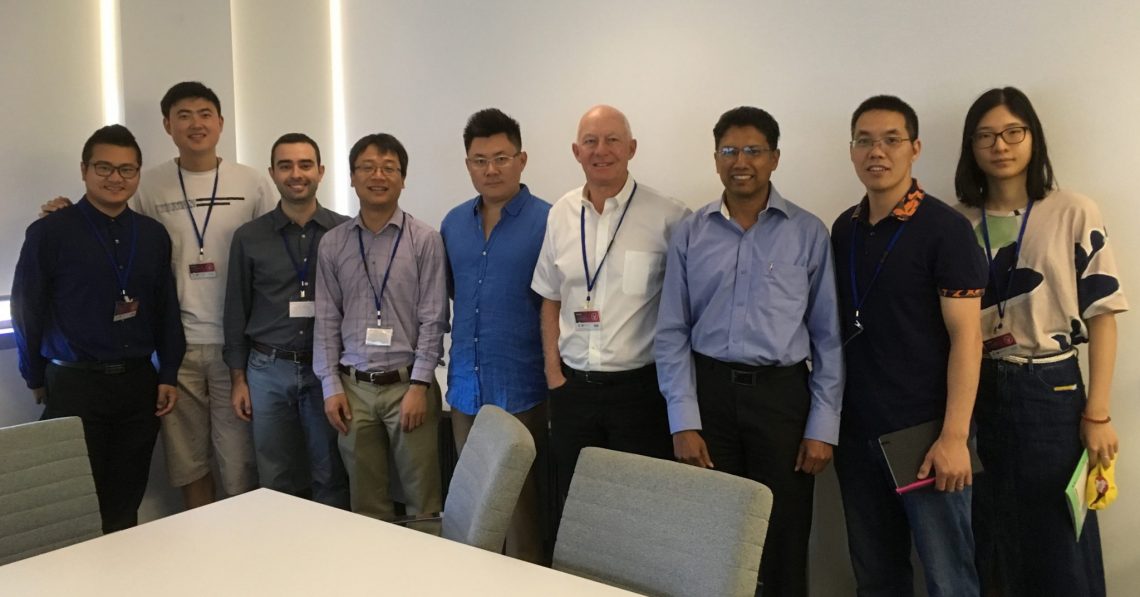
3.48ARC Bridge performance assessment through advanced sensing and modelling (LP160100528)

Project Number
3.48ARCRound
Round 4Date
January 2017 – July 2020Research Team

Chief Investigator
Professor Xiangyu Wang
Project Leader
xiangyu.wang@curtin.edu.au

Chair, Project Steering Group
Professor Keith Hampson
BEng(Civil)(Hons) MBA PhD
FIEAust FAIM FAICD
k.hampson@sbenrc.com.au

Project Manager
Weixiang Shi
Curtin University
weixiang.shi@student.curtin.edu.au
Documents for Downloading
Presentations
Gunawardena, Y. Aslani, F. and Li, J. (2017). Exploratory investigation of monitoring data obtained from an in-service prestressed concrete bridge incorporating a distinct half-joint layout. The 8th International Conference on Structural Health Monitoring of Intelligent Infrastructure (SHMII8), Brisbane, December 2017
Shi, W., Wu, Changzhi and Wang, X. (2018). A Prototype Tool of Optimal Wireless Sensor Placement for Structural Health Monitoring. In: Smith I., Domer B. (eds) Advanced Computing Strategies for Engineering. EG-ICE 2018. Lecture Notes in Computer Science, vol 10864. Springer, Cham.
Zhu, J, Wang, P. and Wang, X. (2018). An Assessment of Paths for Transforming IFC to Shapefile for Integration of BIM and GIS. 26th International Conference on Geoinformatics, China, June 2018
Academic Publications
Li*, H. Hao, G. Fan, P. Ni, X. Wang, C. Wu, J.-M. Lee, K.-H. Jung. (2017). Numerical and experimental verifications on damping identification with model updating and vibration monitoring data. Smart Structures and Systems, 20(2): 127-137. (SCI Q1)
Huang, L., Li, J., Hao, H., and Li, X. (2017). Monitoring blasting events in an underground mine with artificial intelligence techniques. Conference paper accepted by Structural Health Monitoring of Intelligent Infrastructure (SHMII8) (Brisbane, December 2017). https://espace.curtin.edu.au/handle/20.500.11937/70260
Ni, Y. Xia, J. Li*, H. Hao. (2018). Improved decentralized structural identification with output-only measurements. Measurement, 122: 597-610. (SCI Q1)
P. Ni, J. Li*, H. Hao, X. Wang, J. M. Lee, K.H. Jung. (2018). Time-varying System Identification using Variational Mode Decomposition. Structural Control and Health Monitoring, 25(6): e2175. (SCI Q1)
Y. Gunawardena, F. Aslani, J. Li*, H. Hao. (2018). In-situ Data Analysis for Condition Assessment of an Existing Pre-stressed Concrete Bridge. Journal of Aerospace Engineering ASCE,31(6): 04018106. (SCI Q2) Link to document: https://research-repository.uwa.edu.au/en/publications/in-situ-data-analysis-for-condition-assessment-of-an-existing-pre
Xin, Y., Hao, H. & Li, J*. (2019). Time-varying system identification by enhanced Empirical Wavelet Transform based on Synchroextracting Transform. Engineering Structures, 196, 109313. (SCI Q1). Link to document: https://onlinelibrary.wiley.com/doi/full/10.1002/stc.2175
Zhu, J., Wright, G., Wang, J. and Wang, X., 2018. A critical review of the integration of geographic information system and building information modelling at the data level. ISPRS International Journal of Geo-Information, 7(2), p.66.
Shou, W.C., Wang, J. and Wang, X.Y., 2018. 4D BIM for improving plant turnaround maintenance planning and execution: A case study. In ISARC. Proceedings of the International Symposium on Automation and Robotics in Construction (Vol. 35, pp. 1-8). IAARC Publications.
Zhu, J., Wang, X., Chen, M., Wu, P. and Kim, M.J., 2019. Integration of BIM and GIS: IFC geometry transformation to shapefile using enhanced open-source approach. Automation in construction, 106, p.102859.
Bertola, N.J. and Smith, I.F., 2019. A comparison of greedy and global searches for measurement-system design in bridge load testing. In Online Program: 5th International Conference on Smart Monitoring, Assessment and Rehabilitation of Civil Structures (SMAR 2019). German Society for Non-Destructive Testing.
Ian Smith, Professor of Structural Engineering, School of Architecture, Civil and Environmental Engineering (ENAC) at École Polytechnique Fédérale de Lausanne visited Curtin University’s BIM Centre in January 2019 with PhD student Marco Proverbio. Marco gave a talk at Main Roads WA on his analysis of the Rockingham Bridge 1223, comparing model predictions with sensor measurements.
Previous Research
SBEnrc’s research Project 3.48 Sustainable Asset Management: Selecting Optimal Maintenance Strategies Based on Multi-criteria Decision Making has been successful in leveraging into this ARC Linkage project.
Last Updated: 2024-08-06 14:51:07
Australian Research Council (ARC)
Linkage Project
This project is funded partially by the Australian Government through the Australian Research Council.
—-
January 2017 – July 2020
The primary aim of this project is to develop new techniques in creating cyber infrastructure, for bridges in particular, to improve current performance assessment and future capacity estimation. Current sensor data interpretation approaches are weak in assessing the actual infrastructure performance and evaluating the reserve capacity, especially where high levels of systematic modelling uncertainties are not adequately accounted for. A key focus of the project is to ease the current scientific bottleneck in data interpretation. The expected outcome is to optimise infrastructure management and maintenance planning, reduce redundant interventions, guide infrastructure modifications and improve future design.
Objectives
The aim of this project is to develop an innovative approach for assessment of bridge infrastructure performance, based on advanced sensing, modelling and data interpretation technologies, by:
- Creating an automated 3D Model through Point Cloud
- Designing a robust wireless measurement system
- Developing an effective data interpretation approach
- Validating the cyber infrastructure platform
Industry Outcomes
The anticipated outcomes of this project, including model digitalisation, will benefit different industry roles including asset owners, asset maintainers and technology providers.
- For asset owners or maintainers, the proposed approach will improve upon the conventional methods for bridge maintenance, reducing labour cost and time required for inspections and helping to establish efficient training processes for inexperienced engineers through efficient modelling, robust analysis and intuitive visualisation. A significant increase in return on investment can be gained through the digitalisation approach.
- For technology providers, adapting laser scanning, wireless sensor networks, or other sensing and tracking-related products for bridge performance assessment opens up a new market in infrastructure digitalisation. In addition, technology providers can learn about specific requirements in civil infrastructure maintenance and thus refine and improve their related technical support products to fulfil market needs.














